Moldy sourdough starter can be scary, especially when you see green, pink, or black spots growing in your jar. If you’re not sure what to do, don’t worry. This guide will show you how to tell if your sourdough starter is really moldy, how to save it (if possible), and when it’s safer to throw it out and start fresh.
Whether you’re just starting out or have been baking for years, this guide uses very simple English to help you take care of your starter. Most of our readers are women in the United States, so we’ve made sure it’s easy to follow and friendly.
Let’s start with the basics before we jump into the mold problems.
What Is a Sourdough Starter?
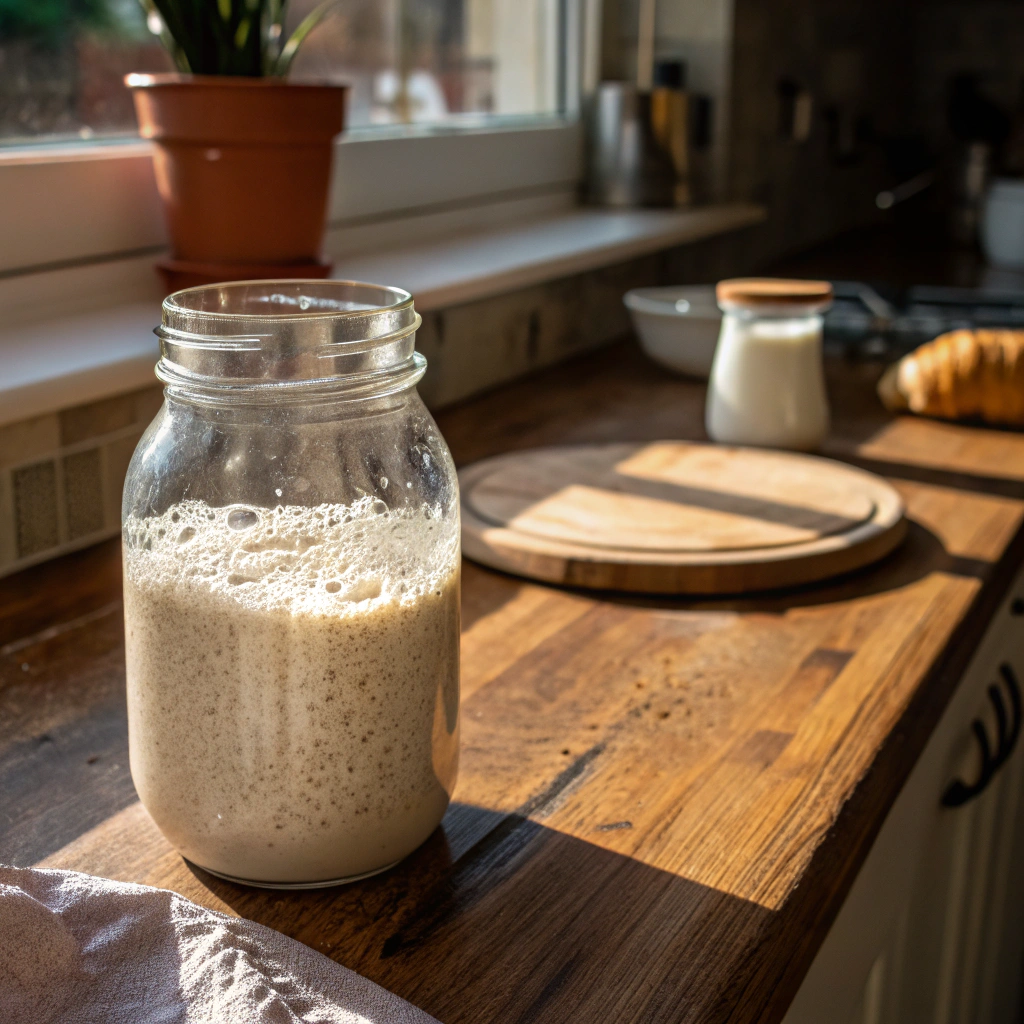
A Sourdough Starter is a mix of flour and water that captures wild yeast and good bacteria from the air. But a moldy sourdough starter can ruin all your hard work if not handled properly. This mix helps your bread rise without using store-bought yeast. But a moldy sourdough starter can ruin all your hard work.
How It Works as a Leavening Agent
When you leave flour and water out, the wild yeast from the air comes in. This yeast eats the flour and makes bubbles—those bubbles help your dough rise. That’s what makes sourdough bread taste tangy and chewy.
You can also check our Sourdough Starter Basics
Common Ingredients and Fermentation
A sourdough starter only needs two things: flour and water. That’s it! Over time, it starts to bubble, rise, and smell sour. That sour smell means the bacteria and yeast are doing their job.
You can use all-purpose flour, whole wheat flour, or rye flour. Whole grain flour usually starts bubbling faster because it has more natural yeast.
How to Identify a Moldy Sourdough Starter Early
Common Visual Signs of a Moldy Sourdough Starter
A moldy sourdough starter usually shows spots that are green, black, or pink. These fuzzy patches often appear on the top or sides of the jar. You may also see a change in color from creamy white to something unusual. White film is usually safe, but colorful fuzz is not.
Smells That Indicate Mold Is Growing
Your nose can detect a moldy sourdough starter before your eyes can. If the smell changes from sour and pleasant to something strong, rotten, or cheesy, that’s a red flag. A sharp ammonia-like odor is another bad sign. When in doubt, sniff it out!
Can a Moldy Sourdough Starter Be Used in Recipes?
Risks of Baking with a Moldy Sourdough Starter
Using a moldy sourdough starter in baking is unsafe. Even if you bake it at high heat, some mold toxins can survive and make the bread dangerous to eat. It’s never a good idea to try and “bake off” the mold.
Why It’s Better to Start Fresh Than Risk Mold
If you find mold, it’s always better to throw the starter away and begin again. A new starter is easy to make and only takes a few days. Don’t risk your health or the quality of your bread by using a moldy sourdough starter.
How to Spot Mold in Your Starter
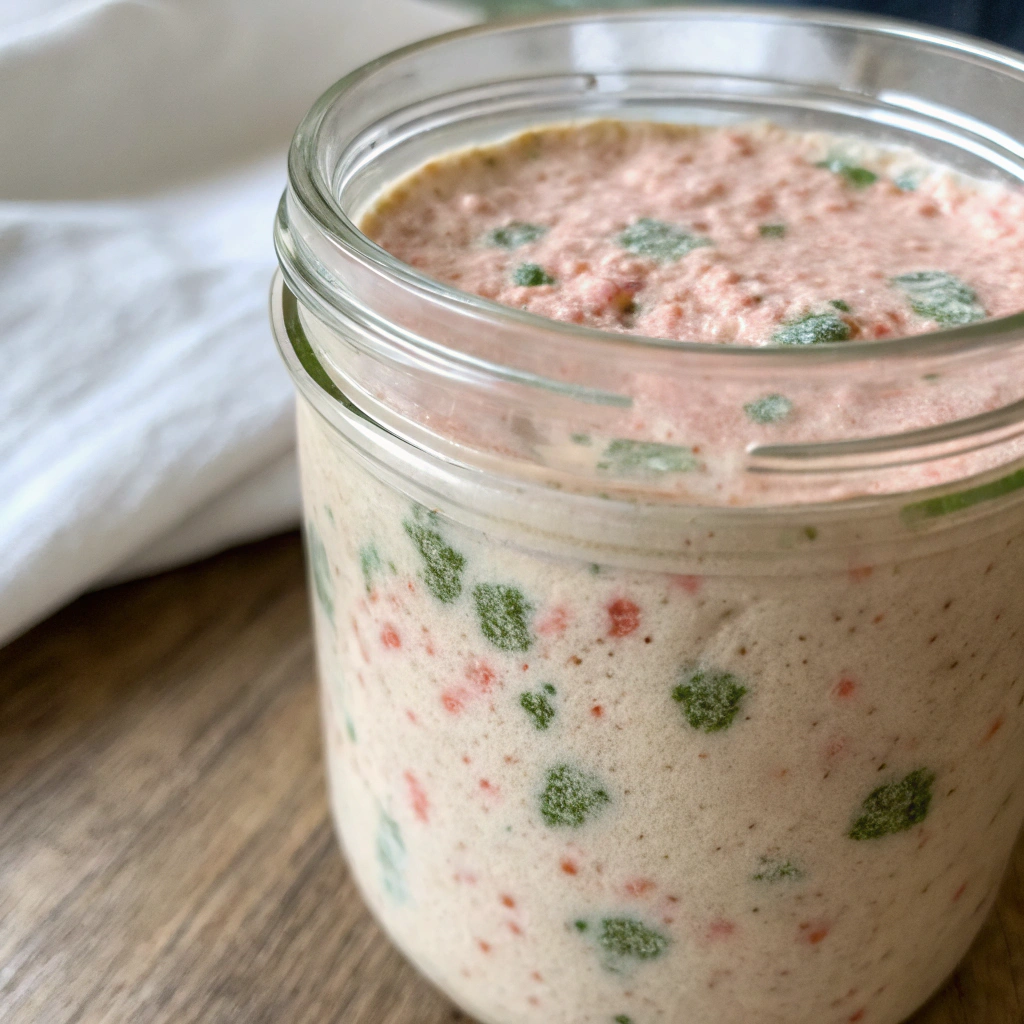
So you’ve opened the jar—and something doesn’t look right. Is that fuzzy stuff mold? Is the starter still safe to use? Let’s find out. One easy way to know you have a moldy sourdough starter is if it smells rotten
White, Green, Black, or Pink Spots
If you see green, black, or pink fuzzy spots, that’s mold. It means you have a moldy sourdough starter, and it’s not safe to use. Mold can grow from bad air, dirty tools, or not feeding your starter enough.
White spots are usually not mold—they’re likely dried flour or bubbles. But if the white stuff looks fuzzy or has a strong smell, you should be careful.
Fuzzy vs. Hazy Layers: What Matters
Fuzzy mold grows like little hairs. It can be green, black, or even red. A hazy layer, on the other hand, might just be dried starter. Look closely. If it moves like powder or looks like cotton, it’s mold.
Smell Tests: Good vs. Bad Starter
A good sourdough starter smells a little sour or yeasty—kind of like yogurt or beer. If it smells rotten, like cheese gone bad, or very strong, it might be moldy. Trust your nose. If it makes you wrinkle your nose, it’s probably not okay to use.
Interesting blog from Kate Chef for more details : Moldy Sourdough Starter [with photos of bad sourdough starter]
Why Mold Appears on Starter
Your sourdough starter is alive. Just like any living thing, it needs care. If you forget to feed it, or if things aren’t clean, mold can show up. Let’s look at the main reasons.
Dirty Containers or Tools
This is the most common reason for mold. If your jar, spoon, or hands aren’t clean, bad bacteria can sneak in. Always wash your hands and use clean jars and utensils. Even a small bit of old starter stuck to the lid can grow mold.
Cold or Warm Temperatures
Mold grows faster when it’s too warm or too cold. Starters like a comfy room temperature, around 70°F (21°C). If it gets too warm, bad stuff grows fast. If it’s too cold, your starter slows down and can’t fight off mold.
Too Little Feeding or Inactivity
If you don’t feed your starter for too long, the yeast and bacteria get weak. Mold takes over. If your starter sits in the fridge for weeks without feeding, it becomes a danger zone for mold.
Some people forget their starter for months. When they open it, they find a scary, moldy mess. Regular feeding helps keep your starter strong and safe—and stops a moldy sourdough starter from forming in the first place.
Mold vs. Hooch: Know the Difference
It’s easy to confuse hooch with mold. But they’re not the same. Hooch is normal and safe. Mold is not. Let’s talk about how to tell them apart.
What Is Hooch, Anyway?
Hooch is a layer of liquid that forms on top of your sourdough starter when it’s hungry. It can be clear, gray, or even brown. It smells like alcohol—kind of like beer or nail polish.
Hooch means your starter needs food. It’s not dangerous. Just pour it off or stir it back in before feeding.
When to Stir Hooch, When to Toss It
If you see hooch and the starter smells fine (sour, not rotten), it’s okay. Stir it back in or pour it out, then feed your starter with fresh flour and water.
But if the hooch smells very bad, and there are colored fuzzy spots with it, that’s not hooch anymore—it’s mold. In that case, toss the starter.
Key Tip: Hooch is usually thin and smooth. Mold is fuzzy, thick, or slimy and comes in colors like pink, green, or black.
When to Save vs. Toss a Moldy Starter
Seeing mold in your starter can be upsetting, especially if you’ve been feeding it for weeks. But don’t worry—not all cases mean it’s over. Let’s look at when you can save it and when it’s best to start fresh.
Signs You Can Salvage It
You might be able to save your moldy sourdough starter if:
- There are no colored mold spots (like green, black, or pink).
- It smells sour or like alcohol, but not rotten or cheesy.
- The texture looks normal, with bubbles and a bit of hooch on top.
- It’s just been forgotten in the fridge for a short while (1–2 weeks).
In this case, remove the top layer carefully and feed the rest with fresh flour and water. Do this a few times and watch for signs of life—bubbles and rising.
When to Discard It Completely
If your starter has:
- Pink, red, green, or black fuzzy mold
- A bad, rotten, or cheesy smell
- Slime, discoloration, or unusual textures
- Been sitting for months without feeding
Then it’s time to toss it. If your moldy sourdough starter has colored growths, it’s not safe to try and save it. Mold spores can spread deep into the jar, even if you don’t see it. It’s better to start over with clean tools and a new mix.
Safety Risks from Mold Types
Some molds create toxins that can make you sick. Even if you scrape off the top, those toxins might be in the rest of the starter. Never take the risk. If you see mold, especially colored mold, throw it away.
How to Clean and Revive If It’s Safe
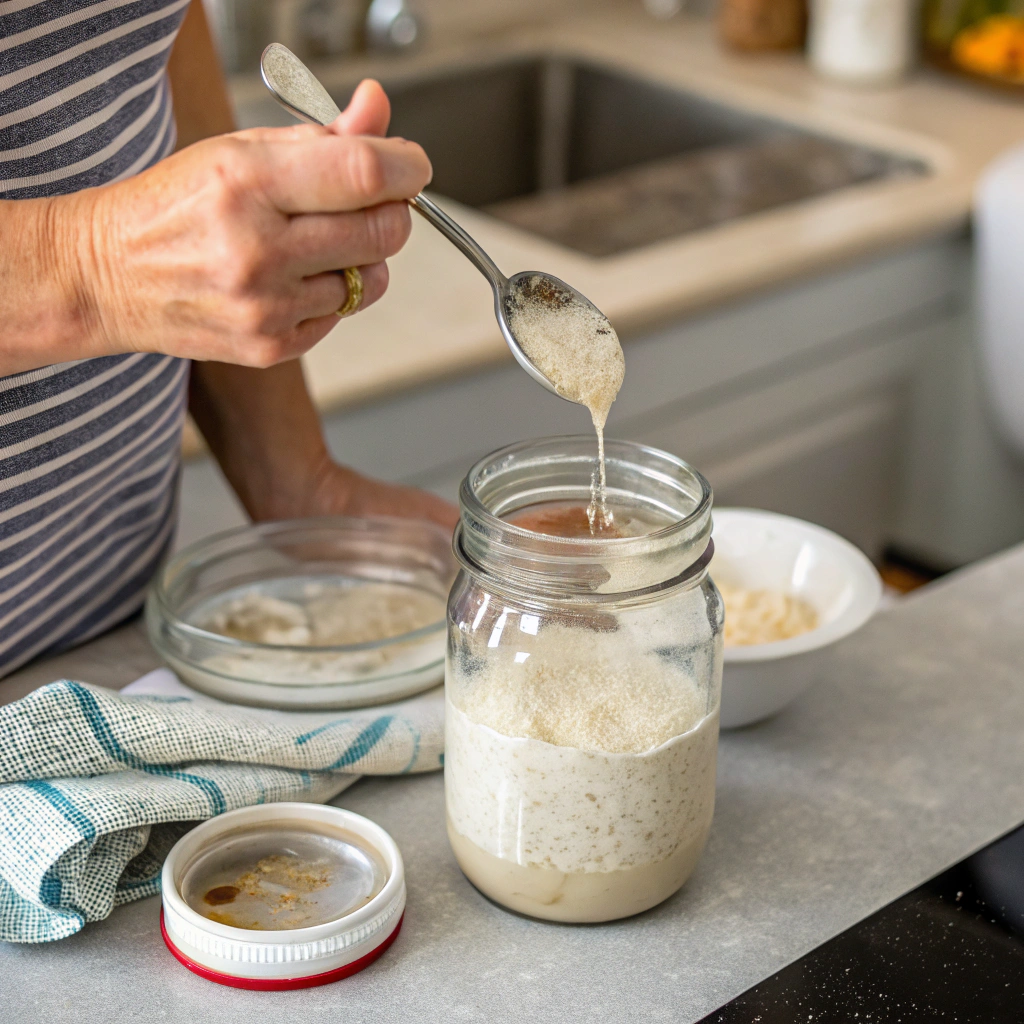
If your starter doesn’t have mold but looks weak or smells strong, here’s how to bring it back to life.
Step‑by‑Step Refresh Routine
- Scoop out the top layer (where hooch or discoloration is).
- Take one tablespoon from the clean part below.
- Mix it with 1/2 cup flour and 1/4 cup water in a clean jar.
- Let it sit at room temperature for 12 hours.
- Repeat this process twice a day for a few days.
Timing and Feeding Strategy
Feed your starter every 12 hours if it’s weak. Use the same amount of flour and a little less water at first to thicken it. A thick starter grows mold slower than a runny one.
As it gets bubbly again, you can feed once a day. After 5–7 days, your starter should be back to normal.
Best Containers to Use
Always use glass jars or food-safe plastic. Avoid metal bowls for storing. Keep the lid loose to let air in, or cover with a cloth and rubber band.
Wash the jar with hot water and soap before starting over. This keeps away bad bacteria.
How to Prevent Mold in Future
The best way to stop mold is by keeping your sourdough starter clean, fed, and happy. A strong starter can fight off bad stuff. Here’s how to protect it long-term.
Use Clean Tools and Bowls
Always use clean hands, jars, and spoons. Wash everything with soap and hot water before using it. Even small crumbs or old flour stuck to the lid can attract mold.
If you reuse the same jar, clean it well every few weeks. You can transfer your starter to a fresh jar while you clean the old one.
Regular Feeding Schedule
Your starter needs regular food to stay strong. A weak starter can’t fight off mold.
- Room temperature: Feed once a day
- Refrigerated starter: Feed once a week
If your starter goes too long without food, it starts to smell, separate (with hooch), and may attract mold. Set a reminder on your phone to feed it!
Store at Correct Temperature
Starters like to be warm—but not too warm. Keep it between 65°F to 75°F (18°C to 24°C).
- Too warm? Bacteria grows too fast, including the bad kind.
- Too cold? The good yeast slows down, and mold may take over.
Covering vs. Sealing – What’s Best?
Don’t seal your jar too tightly. A tight lid keeps out air, and yeast needs air to grow.
Instead, cover the jar with a clean towel, plastic wrap with holes, or a lid that’s loosely placed. This keeps bugs and dust out but lets the air in.
Red Flags: When to Start a New One
Sometimes it’s better (and safer) to say goodbye to your starter and begin again. Here are the top signs that it’s time to toss it and make a fresh one.
Pink or Black Mold Appears
Pink or black mold is a serious warning. It’s not safe. These molds can release toxins that go deep into the starter—even if they look small.
If you see pink streaks or black fuzzy dots, don’t take risks. It’s time to toss the whole thing.
Starter Smells Rotten or Seriously Off
Sourdough should smell a little sour, like yogurt or vinegar. If it smells like:
- Dirty socks
- Rotten meat
- Strong ammonia
- Cheese gone bad
…it’s likely unsafe. Mold may not always be visible, but smell can warn you first.
When in doubt—throw it out.
How to Safely Throw Away Moldy Starter
Throwing away moldy starter the right way helps protect you, your home, and your tools from mold spores.
In Sealed Bag into Trash
- Scoop the starter into a plastic bag—don’t pour it down the sink.
- Seal the bag tightly.
- Place in your outdoor trash (not inside your kitchen bin).
This keeps mold spores out of your kitchen and prevents clogging your pipes.
Sterilize Jar Before Re‑using
After tossing the starter:
- Boil the glass jar for 5–10 minutes, or
- Wash it in hot soapy water, then wipe with white vinegar.
Let it dry completely before starting a new batch. This kills any leftover mold spores that could spoil your next starter.
For more delicious recipes and cooking inspiration, follow me on Facebook and Pinterest!
FAQs About Moldy Sourdough Starter
Can I still use my sourdough starter if it has mold?
No. If your sourdough starter has mold, it’s safest to throw it away and start fresh.
What does mold look like on sourdough starter?
Mold can look white, green, black, or pink. It usually looks fuzzy and grows on the top or sides of the jar.
How can I prevent my sourdough starter from getting moldy?
Keep your jar clean, feed your starter regularly, and store it in a cool, dry place with a loose lid.
Can I freeze my sourdough starter to avoid mold?
Yes! Freezing your starter is a great way to pause fermentation and reduce mold risk.
Can I Use the Unmolded Part of a Moldy sourdough starter ?
No. Even if mold is only on top, the spores can travel through the entire starter. It’s not safe to scoop off the top and keep the rest. If there’s mold, throw the whole thing away.
Is It Dangerous to Bake With It?
Yes, it can be. Moldy starter can carry harmful toxins. Baking might kill some germs, but not all mold toxins. It’s not worth the risk to your health.
How Often Should I Feed It?
– If stored at room temperature: Every day.
– If stored in the fridge: Once a week.
Regular feeding keeps your starter strong and less likely to grow mold.
Final Thoughts: Starter Safe or Swap?
Taking care of a sourdough starter is like having a tiny pet in your kitchen. If you notice a moldy sourdough starter, now you know how to handle it safely. It needs regular feeding, a clean home, and some attention. Mold can happen if it’s ignored or not stored well—but it’s not the end of the world.
If your starter is moldy, throw it out and start fresh. If it just smells a little strong or has hooch, you might be able to save it. Trust your eyes, nose, and gut feeling.
Once you learn how to spot mold and how to prevent it, you’ll be ready to bake delicious sourdough bread without worry.
If you liked this, you’ll also like…
- How to Feed a Sourdough Starter in the Fridge: Easy Steps & Pro Tips
- What As A Stiff Sourdough Starter ?
Want to take your sourdough skills further? Start with our complete guide: 7 Essential Steps to Mastering Your Sourdough Starter.
If you’re wondering what a ready sourdough starter should look like or simply how it looks at different stages, we’ve got you covered. You’ll also learn how to feed your starter when it’s in the fridge, how to spot and fix mold issues, and the difference between a liquid starter and a stiff sourdough starter.
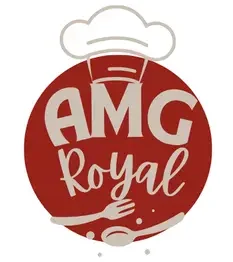
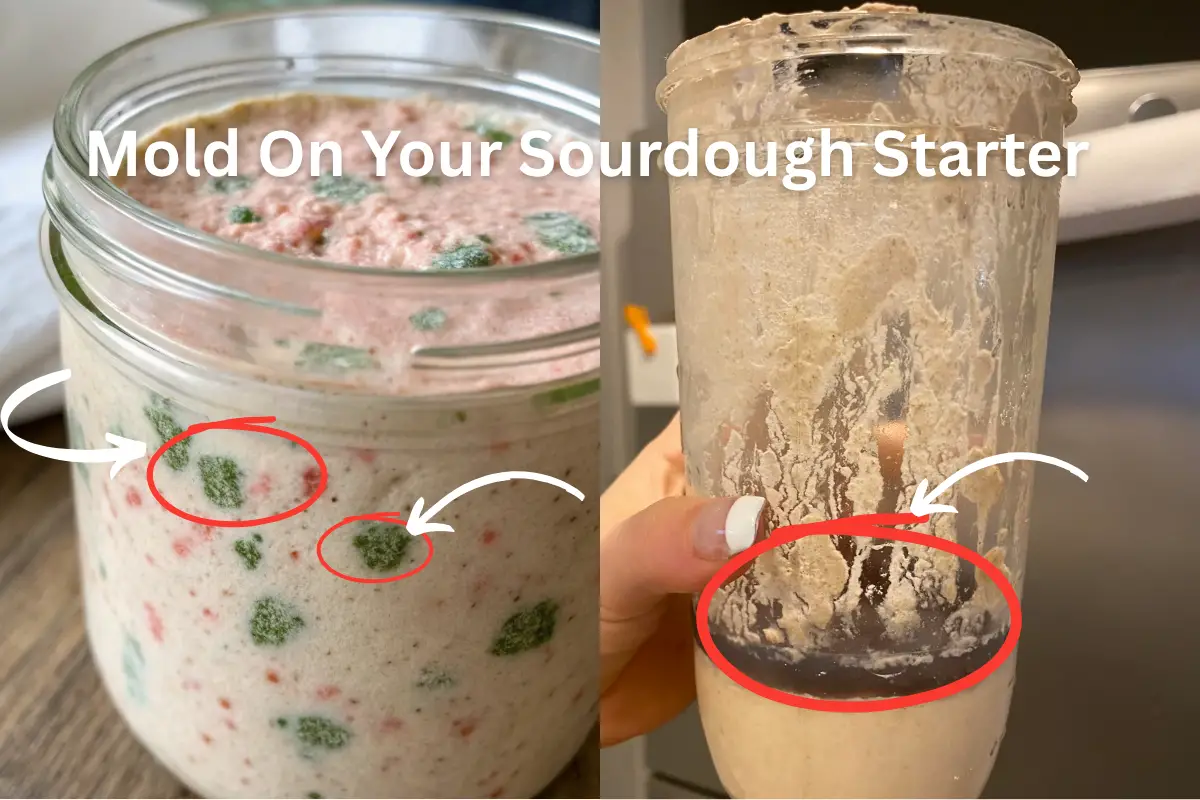




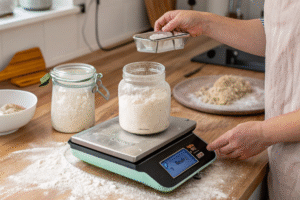
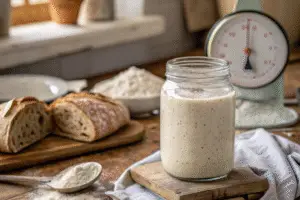
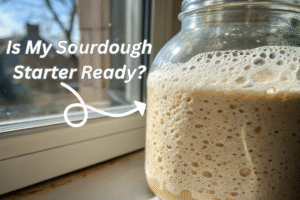
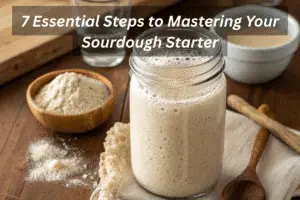
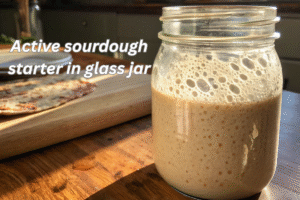
1 thought on “Moldy Sourdough Starter: Easy Guide to Save or Start Over”